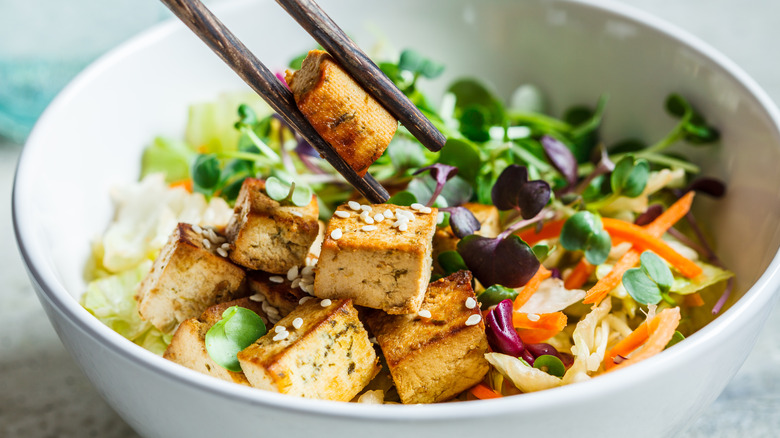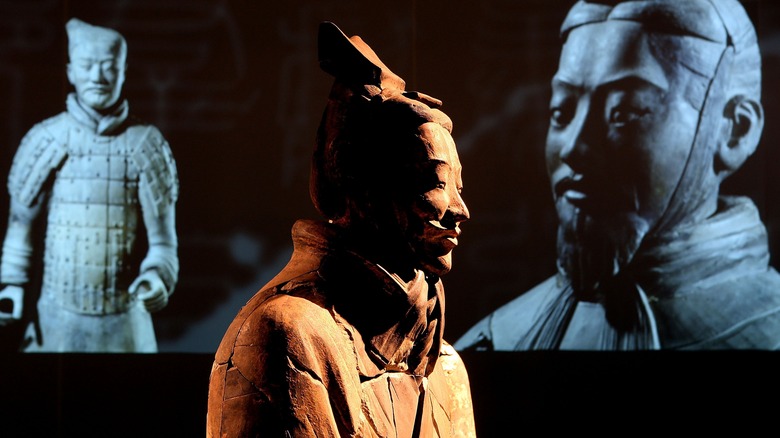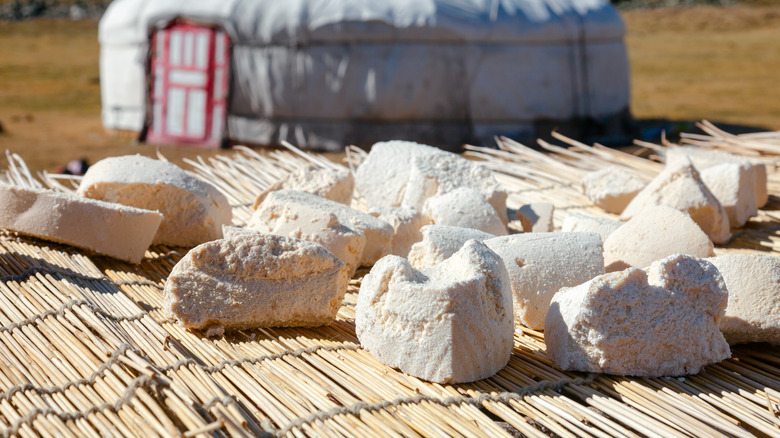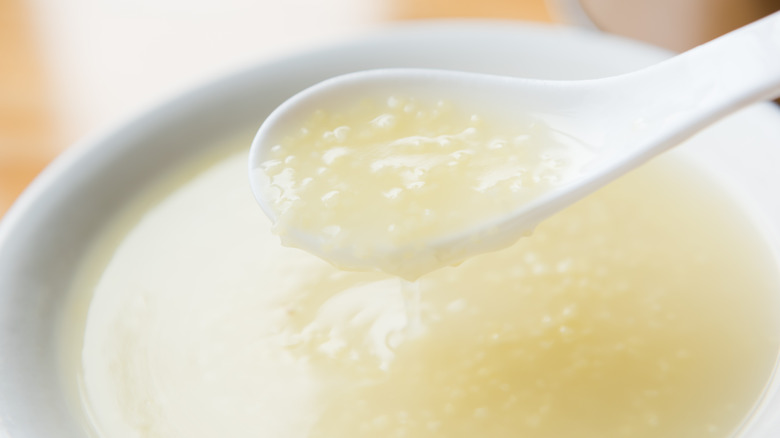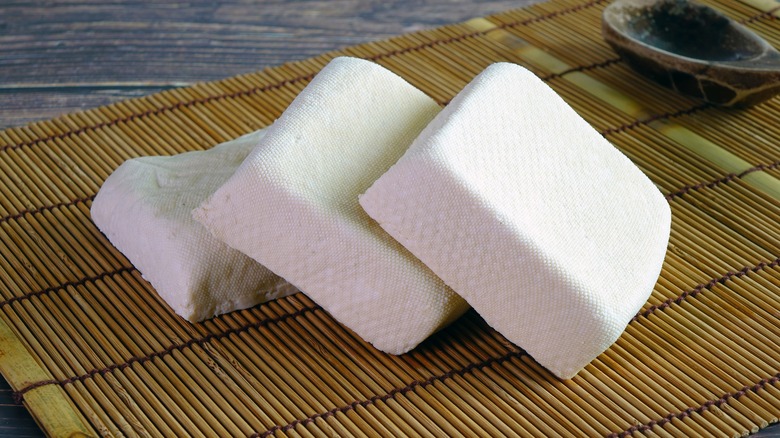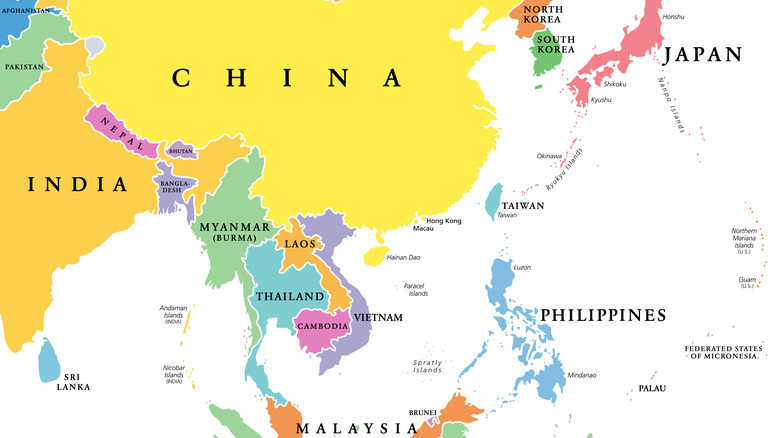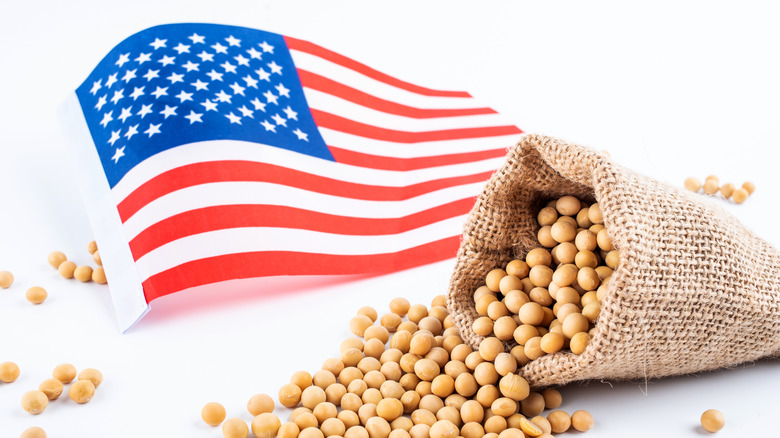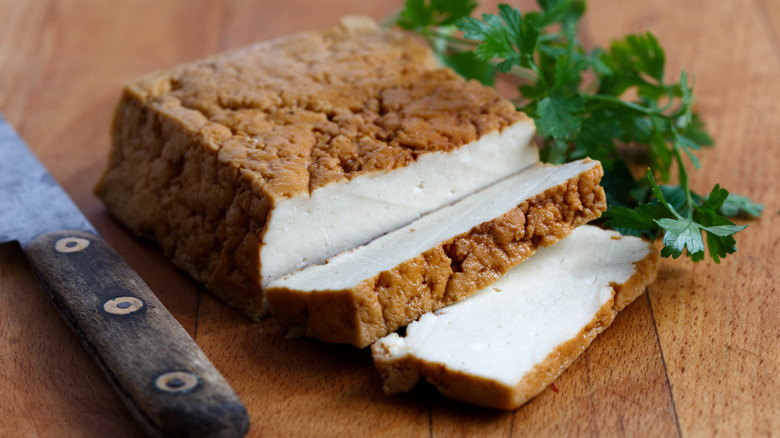The Ancient History Of Tofu
You can bake it, air-fry it, crumble it over salads, slice it thin over eggplant, serve it in chunks for a hot brothy soup — tofu is one of the most versatile plant proteins around. With its mild flavor, it suits almost any kind of meal. You can substitute it for eggs in fried rice, for example, or you can use it instead of mozzarella in a Caprese salad. It is very much a staple of Japanese cuisine, but did you know that tofu has its origins in China?
Over 2,000 years ago, the Chinese were using a food staple they called "doufu." However, its exact origins have been widely debated, to say the least. While there are references in literature to soybeans, soy curd, and even tofu itself (variations on the word began popping up as early as 950 AD), the jury is out on who invented the block of soybean curd that has endured in Asian cultures for centuries.
Here, we explore the different theories and how its usage spread to various parts of Asia and, eventually, the United States.
Origin theory 1: Invented by a Chinese king
In China, it's common for historical figures to get the credit for great achievements, including culinary ones. It's said that Liu An (179-122 BC), a former ruler of the Han dynasty kingdom Huainan, invented the block of vegetarian protein that we call tofu. There are a couple of other tofu origin stories, but this one is by far the best-known. So, who was Liu An?
In addition to his royal status, Liu An was known as a philosopher and a scholar. Legend has it that he first ground soybeans to form a milk to help his ailing mother. This led to his discovery of bean curd, and the beginnings of tofu. Some say that he invented tofu by accident when some brine got into a soy milk mixture he had concocted for the purposes of alchemy. Liu An was well-known for his interest in alchemy, magic, and Taoism, which is perhaps why he has been credited with creating tofu.
Ancient texts suggest that Liu An was obsessed with the idea of immortality, and that he began dabbling in alchemy hoping to achieve this. It's been said that tofu was the result of his experimentation, the first superfood. However, while the health benefits of tofu are well documented, folkloric texts suggest that Liu An's tofu did way more than provide him with protective antioxidants and manage his blood sugar. According to the writings of Sun Ta-ya of the Yuan dynasty, Liu An actually started becoming younger and eventually grew wings that allowed him to fly to heaven.
Like a vegan tofu stir-fry, the story of Liu An is better taken with a pinch of salt.
Origin theory 2: Inspired by Mongolian cheese-making techniques
The next tofu origin theory is a lot more believable than the one involving Liu An. Some suggest that the ancient Chinese learned the art of milk curdling (a process for making tofu) from the Mongolian tribes to the north, who were known to make cheese. This theory has some weight to it, seeing as milk culturing (soy milk in the case of tofu) didn't exist in China prior to the arrival of the nomadic Mongolians.
Japanese texts suggest that the tribes from Mongolia came to China between the 4th and 7th centuries AD, introducing the locals to their cheese-making techniques. According to this theory, the Chinese then adapted their technology of culturing milk and began processing soybeans to form a similar type of fermented food with the consistency of softened, yogurt-like cheese.
Tofu is processed by adding a coagulant such as calcium sulfate or the mineral-rich Nigari (unrefined sea salt) to hot, fresh soy milk to make it curdle. The curds formed are then separated and shaped into the tofu blocks we know today. According to Soy Info Center, it's likely that the Chinese began "substituting various indigenous mineral salt or acid coagulants for the rennet and bacterial cultures" used by the Mongolians.
Origin theory 3: A happy accident
Did a Chinese chef accidentally create one of our most beloved health foods by fermenting a soybean-derived food by mistake? This final theory on the origins of tofu is based on a chemical reaction that can occur when a natural coagulant is combined with cooked soybeans. It's thought that the ancient Chinese dried out their soybeans and used them in a variety of ways. Mashed into a puree, these dried soybeans could be used to create a porridge-like dish. If a Chinese cook happened to use an unrefined sea salt — which contains nigari, a natural coagulant — to season their porridge, this would have led to the formation of curds.
Could this be the real origin of tofu? Perhaps, but there are other ways that tofu could have been invented via a happy mistake. It's also possible that the chef in question simply left their porridge mixture out in the heat long enough that lactic acid-producing bacteria formed, which would have resulted in curds. If the cook then decided to strain the porridge mixture to remove the pulp, said curds would greatly resemble what we know today as tofu.
Etymology of tofu
How did tofu get its name? It's an interesting story that lends more weight to the theory that tofu came about after nomadic Mongol tribes shared their dairy know-how with their neighbors to the south. It's said that the Mongolian name for fermented milk was rufu, and that's where it all began. "In order to write this word in Chinese, the Chinese had to choose two characters which had the sounds of those two syllables," explains Soy Info Center. "Fortunately, the character meaning 'milk' was pronounced ru. To convey the sound fu the Chinese selected a character that ordinarily meant 'spoiled.'"
The ancient Chinese considered soybeans to be one of five sacred grains, so it may seem odd that they named a by-product of this grain using a character that means "spoiled." But, truth be told, people eat plenty of products that have signs of being past their prime. Blue cheese might seem gross in theory, but combine it with mushrooms and some pesto and you've got a delicious appetizer. It all comes down to personal taste.
Before long, the ancient Chinese had fallen in love with tofu, which had different names in different Chinese languages. In Mandarin, it became known as "doufu." Cantonese speakers, meanwhile, began referring to it as "tau-fu." You're probably thinking that this is where "tofu" comes from, but "tau-fu" is pronounced "DAU-fu." The word "tofu" is actually Japanese, and it first appeared in literature in 1182.
The spread of tofu in Asia
So, we know that "tofu" is a Japanese word, but when did it first arrive there? According to the Japan Tofu Association, Japanese envoys to China during the Nara (710-784) and Heian (794-1185) periods were likely introduced to tofu during their visits. It became a staple protein source for Buddhist monks in Japan, who were strictly vegetarian. Tofu was a luxury for a long time and didn't become widely available until midway through the Edo period (1603–1868). Today, there are hundreds of different types of tofu in Japan.
Tofu was widely available in Korea (where it got the name "dobu") by the 15th century, though it's thought to have arrived there during the Goryeo period (918-1392). People began making it at home and it was often fed to malnourished prisoners after their release from jail. Eating tofu upon release is still a thing today, though it's largely a symbolic gesture, as prisoners are much better fed than they were at the time.
Vietnam also has a long history with tofu, largely due to the fact that it was a Chinese colony from 111 BC to 939 AD. The Vietnamese call it "dau pu" or "dauhu," and it's often combined with meat in dishes as opposed to being used as a meat substitute. Tofu arrived in Indonesia (where it's known as "tahoe") via spice traders and is widely consumed, and it's also popular in Myanmar, though it's made with chickpea flour instead of soybeans. Thailand and India didn't take to tofu until relatively recently — it became popular in the mid and late-1900s, respectively.
Becoming popular in the U.S.
According to the South China Morning Post, founding father Benjamin Franklin became interested in tofu back in the 1760s. The founding father read about it in a book written by a Dominican missionary who had visited China. Despite his interest in this supposedly revolutionary foodstuff, it remained alien to America until around a century later when Asian migrants came to work on the railroads. Both Japanese and Chinese railway workers kept their dietary customs, and thus tofu became commonplace in Asian-American communities.
The first American tofu company popped up in the 1870s, but it would be another hundred years or so before the interest of the wider public was piqued. The counterculture movement of the 1960s and 1970s led to vegetarianism becoming more mainstream. Vietnam War protesters became interested in Vietnamese culture and a greater interest in Asian spirituality surfaced. A man named Bill Shurtleff, who discovered tofu while living with a Zen Master in a Californian monastery, wrote "The Book of Tofu" with his Japanese wife Akiko Aoyagi, and it changed everything.
Released in 1976, the book shed light on the benefits of tofu and included instructions for making it. The couple went on a nationwide tour to sell the book and spread the word. With over 600,000 copies sold, the book's success marked a huge drive in the tofu movement. This sparked non-Asian production of tofu and boosted the success of tofu-producing Asian markets at the same time.
Types and varieties of tofu
There are various types of tofu, from the soft, silken type to firm (and extra firm) kinds. Silken tofu is derived from the Japanese method of molding the tofu in silk linens. It is neither drained nor pressed, and it is smooth. As such, it contains the highest water content of all tofu varieties and is ideal for making custards or puddings. Firm tofu, on the other hand, is pressed to a solid compactness that won't crumble. It's common and versatile for various methods of cooking, from stir-frying to baking. Extra firm tofu is even denser and won't absorb much flavor, but holds up even better in various methods of heating.
In addition to texture types, tofu also comes sprouted, flavored, and in a not-so-common variety known as Kori tofu. Sprouted tofu is the easiest to digest and has more nutrients than typical tofu varieties, with a higher percentage of protein, calcium, and vitamin D. When soybeans have been left to sprout, starches and phytates are broken down, making the nutrients more bioavailable. Flavored tofu includes smoked, seasoned, and fried versions, and generally means less time in the kitchen. Lastly, Kori tofu is cured and dried out in low temperatures to preserve it. It's a frozen product, making it a convenient option for soups and stews.
